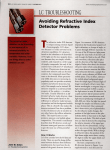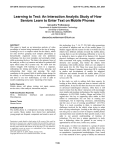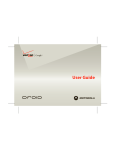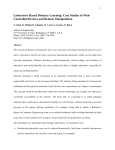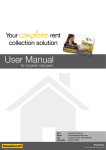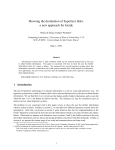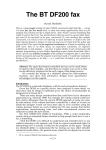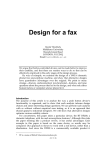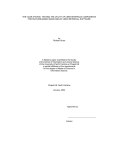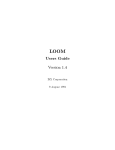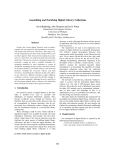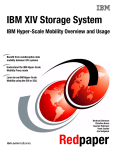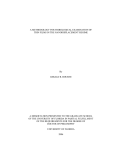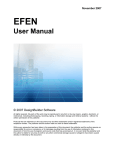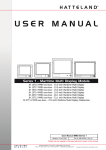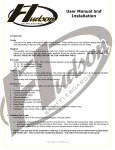Download as a PDF
Transcript
Petri Net Based Hypertext:
Document Structure with Browsing Semantics
P. David Stotts
Richard Furuta
Department of Computer Science and
Institute for Advanced Computer Studies
University of Maryland
College Park, MD 20742
Abstract
We present a formal de nition of the Trellis model of hypertext and describe an authoring and
browsing prototype called Trellis that is based on the model. The Trellis model not only represents
the relationships that tie individual pieces of information together into a document (i.e., the adjacencies)
but speci es the browsing semantics to be associated with the hypertext as well (i.e., the manner in
which the information is to be visited and presented). The model is based on Petri nets, and is a
generalization of existing directed graph based forms of hypertext. The Petri net basis permits more
powerful speci cation of what is to be displayed when a hypertext is browsed and permits application
of previously-developed Petri net analysis techniques to verify properties of the hypertext. A number
of useful hypertext constructs, easily described in the Trellis model, are presented. These include the
synchronization of simultaneous traversals of separate paths through a hypertext, the incorporation of
access controls into a hypertext (i.e., specifying nodes that can be proven to be accessible only to certain
classes of browsers), and construction of multiple specialized (tailored) versions from a single hypertext.
CR categories: I.7.m (hypertext), F.1.1 (Petri nets), H.3.4
General terms: hypertext, Petri nets, browsing semantics, formal model, synchronization, access control, versions
Additional Key Words and Phrases: Trellis model of hypertext
1 Introduction
Hypertext is a structuring mechanism for information, one that is particularly well-suited for use on an
interactive computer. Hypertext is not a new idea. Bush 3] is credited with the rst proposal for such
a system, which he called the \memex," in 1945. Brown University's HES 5] and Engelbart's NLS 13,
14] are early implementations of computer-based hypertext systems, dating from the late 1960's. Only
in recent years have hypertext systems become widely available. Commercially-available systems such as
Apple's HyperCard and Shneiderman's Hyperties 25, 21] may be purchased for use on personal computers.
Research systems such as Xerox's NoteCards 17] show the wide range of components that are useful in a
hypertext and the dierent presentations that help make it more understandable.1
Traditionally, a hypertext is composed of information fragments (text, graphics, sound, video, etc.) and
tangible relationships among these fragments. One way to represent such a document is as a directed graph.
Each information fragment is associated with a node in the graph, and the directed arcs represent the
Supported in part by a grant from the National Science Foundation, CCR{8810312.
Two recent surveys of the hypertext eld are 8] and 2]. In addition, 30] presents a perspective on the history and
development of the area.
1
1
relationships among nodes. In this interpretation, the arc represents a potential traversal from the source
node of the arc to the destination node. A person browsing a hypertext traverses the graph and views (or
hears) the information fragments as he visits nodes.
Some researchers are beginning to realize the need for a more formal substructure for the highly implementation-de
ned eld of hypertext for example 12] and 16]. Projects are beginning to appear that attempt
to construct a more complete and descriptive mathematical basis for documents than directed graphs and
annotations can provide.
The work described in this report is based on one such mathematical framework|that provided by a Petri
net. The Trellis model essentially provides a unifying formalism for describing and reasoning about many
of the features of existing hypertext systems. The model also naturally expresses and manages concurrent
browsing paths, an area of hypertext that has not been fully explored. Another advantage of this approach
is that a Petri net is an incremental change to the commonly understood directed graph formalism, not a
wholesale replacement of that representation, and results developed for directed graph based hypertext are
easily adapted to a Petri net formalism. Unlike a directed graph alone, though, a Petri net also permits the
speci
cation of a hypertext's browsing semantics, that is, the dynamic properties of a reader's experience
when browsing a document. This is due to the dual nature of Petri nets: they are easily and naturally
represented as bipartite directed graphs, but they are automata as well and have inherently parallel execution
semantics. As automata they also have formal language properties and can be viewed as language generators
and recognizers. These dierent but interchangeable aspects of nets provide analytical leverage for the
solution of several interesting access control and version problems in hypertext.
Petri net formalism has long been recognized as as eective tool for describing and analyzing control
ow among concurrent activities. Though we know of no other use of Petri nets in describing hypertexts,
Petri nets have been used to model user interactions and interfaces. For example, Zisman 34] describes a
model for activity coordination in oce automation environments in which Petri nets are used to specify
the possible interactions among a set of active agents. The agents themselves are represented as production
systems that specify computational behavior. In another project, van Biljon 29] has used Petri nets to
specify user interfaces, calling them man-machine dialogues. For illustration he models a simple operating
system shell. These practical uses of Petri net theory are similar in goals and approach to the Trellis model
described herein, but our work is cast directly into the hypertext domain and addresses some of the unique
problems found there.
In the following section of this paper we present a brief review of Petri nets and then we present our
formal hypertext model. Following the presentation of the model, Section 3 describes Trellis, a prototype
Petri net based hypertext system. Section 4 then presents the solution to some speci
c hypertext problems
as an illustration of the analytic power of our formalism. A discussion of useful extensions and further
implications of the Trellis model, in Section 5, completes the report.
2 The Trellis model of hypertext
The formal model of hypertext that we propose is based primarily on a Petri net representation of a document's structure. We take advantage of the fact that Petri nets not only capture the descriptive power of
directed graphs, known to be a useful abstraction in hypertext systems, but provide as well a mathematically
precise abstract machine for control and analysis of hypertext \execution," or \browsing."
For completeness of our discussion, and to motivate the descriptive power of our approach, we rst
provide a short set of de
nitions for the Petri nets we employ. Following them, we give the de
nitions for
our hypertext model. Readers familiar with basic Petri net theory can skip directly to Section 2.2 without
loss of understanding.
2.1 Basic Petri net theory
To provide a complete presentation of the Trellis hypertext model, we review rst the basic points from
Petri net theory that are used in the later de
nitions. Readers who desire a more thorough exposition of net
2
theory can consult the texts by Peterson 23] and Reisig 24]. The notation used here is taken from Reisig.
De nition 1 Petri net structure
A Petri net structure is a triple, N =< S T F > in which
S = fs1 : : : sn g is a nite set of places with n 0,
T = ft1 : : : tm g is a nite set of transitions with m 0, and S \ T = ,
F (S T ) (T S) is the ow relation, a mapping representing arcs between places
and transitions.
The arcs represented by F prescribe pre and post relations for places and transitions. The set of places
that are incident on a transition t is termed the preset of t and is denoted by
t = fs j (s t) 2 F g:
The set of places that follow a transition t is termed the postset of t and is denoted by
t = fs j (t s) 2 F g:
The preset and postset for a place s are de
ned similarly as the sets of transitions incident on s and following
s respectively.
In our model, we have simpli
ed the notation often used for Petri nets by assuming that the weight on
each arc is 1, and that the token capacity of each place is unbounded.
De nition 2 Marking
A marking M of a Petri net structure N =< S T F > is a function
M : S ! f0 1 : : :g f!g
mapping each place in the net into either a nonnegative integer or the symbol !. A marking is
normally written as a vector (m1 m2 : : : mn ) in which mi = M(si ).
Each integer in a marking indicates the number of tokens residing in the corresponding place. The symbol
! represents an arbitrarily large number of tokens, and is included for consistency with existing net theory.
It may appear in Petri nets representing an in
nite number of states.
An execution of a Petri net consists of a sequence of markings, beginning with the initial marking M0
and ending in some nal marking Mf (which can be de
ned in several dierent ways see 23]). To go from
the current state M to some next state M , any transition t that is enabled under M is chosen and red.
For a transition t to be enabled under M, it must be the case that
8s 2 t : M(s) 1:
Firing t consists of removing one token from each place in t and adding one token to each place in t. The
new state M is then the tuple of integers showing the number of tokens in each place after the ring.
For example, consider the marked Petri net shown in Figure 1. Places are drawn as circles, transitions as
bars, and tokens as dots in places. The initial marking, shown in part (a), is M0 = (111000). The enabled
transitions under M0 are t1 and t2 . If t1 were chosen to re, the resulting next state would be M1 = (001111),
as shown in part (b). If instead from the initial state transition t2 were red, the resulting state (100000)
would be terminal since no further transitions would be enabled. Note that the number of tokens in s4 is
increased by 1 every time that t1 is red hence s4 acts as a counter.
Being a nite automaton, a Petri net has a dual mathematical nature. It can be viewed as generating (or
representing) a formal language, and it can also be viewed as an abstract machine. From the formal language
viewpoint, a Petri net describes a set of strings of symbols in which each symbol represents a transition in
the net. From the automaton viewpoint, a Petri net is a state transition system in which the number of
tokens in each place collectively constitutes the state of the abstract machine. Both views are of value to us
when interpreting a Petri net in terms of a hypertext.
0
0
3
s1
s2
s1
s3
t1
t2
s2
s3
t1
t2
s6
s4
s6
s5
s4
s5
t3
t3
(a)
(b)
Figure 1: Petri net before and after transition ring.
2.2 Formal denitions of Trellis
The Trellis model of hypertext uses Petri net structure and execution semantics to specify both the linked
form and the browsing semantics of a hypertext. This logical structure then is interpreted through a layer
of indirection to arrive at a displayed form for reader consumption. Hypertext content and linked structure
are eectively separated by the Trellis model.
De nition 3 Hypertext
A hypertext H is a sextuple H =< N C W B Pl Pd > in which
N =< S T F > is a Petri net structure,
C is a set of document contents,
W is a set of windows,
B is a set of buttons,
Pl is a logical projection for the document,
Pd is a display projection for the document.
A hypertext consists of a Petri net representing the document's linked structure, several sets of humanconsumable components (contents, windows, and buttons), and two collections of mappings, termed projections, between the Petri net, the human-consumables, and the display mechanisms. A Petri net is a bipartite
directed graph, and as such, is as capable of representing a linked hypertext as existing models using directed
graphs alone.2 A window from set W is a logically distinct locus of information.3 A button from set B is an
Any directed graph has a simple representation as a Petri net the bipartite nature of a Petri net is important for the
execution semantics and does not restrict its structural modeling power. See Section 5.
3 The locus of information represented by a \window" is not necessarily visible. Indeed, a logical window may require other
devices, such as an audio generator, for presentation of its information. Note that the model does not require that a logical
window be associated with each net place (see the denition of Logical Projection, below). This is useful when a place is
mapped to a computation that does not create presentable information, e.g., an action node in NoteCards.
2
4
s2
s1
t3
s6
t1
t4
t10
s3
s7
s8
s4
t5
s5
s9
t2
s10
t6
s12
s11
s13
t8
t7
t9
Figure 2: Example Petri net hypertext structure
action that causes the current display to change in a speci
ed way. A content element from the set C can
be many things: text, graphics, tables, bit maps, executable code, audio information, or, most importantly,
another hypertext. Figure 2 shows an example of a Petri net structure for a hypertext. It will be used as
the basis for further examples.
De nition 4 Logical Projection
Given the Petri net structure N =< S T F > in a hypertext H, the logical projection of H is
a triple Pl = < Cl Wl Bl > in which
5
C l : S ! C f g
Wl : S ! W f g
Bl : T ! B f g
A logical projection provides mappings from components of a Petri net to the human-consumable portions
of a hypertext as mentioned above. The in the de
nition is a special item denoting a null value. The
function Cl associates a content element with each place in the Petri net N. The function Wl associates a
logical window with each place in N as well. The function Bl associates a logical button with each transition
in N. A transition is red by selecting its associated logical button. Buttons can thus be thought of as the
mechanism that couples hypertext browsing with Petri net execution. Together, these mappings provide an
informational form and a logical layout for the browsing structure of the Petri net.
As mentioned above, content elements may be more than simple information. A Petri net place may
have as its contents another hypertext, creating a natural hierarchy in the model. The uses for hierarchical
structure in a hypertext are numerous. One obvious advantage is that each Petri net is independently
analyzable. Many analysis algorithms for Petri nets are exponential in the size of the net, so a collection of
smaller nets is preferable to one large net. Another advantage is that with careful use of hierarchy an author
can organize a hypertext more eectively than with a at structure. For instance, hierarchy can provides a
form of abstraction. Browsing semantics can be designed so that the initial display of a lower level hypertext
shows an overview of its contents. The detailed text can then be browsed for more information, or it can be
skipped by moving on at the upper level.
The display projection Pd is simply a collection of mappings that associate the logical buttons and windows
of a hypertext with physical screen representations and locations. For example, given a text segment displayed
in a physical window, one way to represent the logical buttons is to map them to a menu of mouse-selectable
items located next to the text window this is the approach in the current Trellis system, explained in
Section 3 below. Another way is to map them onto words actually in the text window. Either mechanism
(or others) can be used without altering the logical hypertext structure simply by appropriately specifying
the display projection. Since our emphasis here is on logical representation and analysis, we will not present
this aspect of the model in any detail.
There are, in summary, two important levels of indirection in this model. The rst is the separation
of content from structure. By appropriate selection of the logical mappings Pl one structure can serve to
represent several document versions (see Section 4.5). The second level is the display projection Pd , which
allows a set of logical entities to be presented in dierent forms for consumption. For example, logical buttons
that exist but are not selectable (due to the Petri net marking) can either be shown on a screen \grayed
out" (as in the well known Apple Macintosh menu format), or they can simply not be displayed at all. This
second approach has implications for document security: if information is not attainable, its existence is not
even admitted (see Section 4.4).
De nition 5 Marked Hypertext
A marked hypertext is a pair HM =< H M > in which
H =< N C W B Pl Pd > is a hypertext,
M is a marking for the Petri net N in H.
A marked hypertext can be thought of as representing the state of a hypertext during browsing. It is
a characterization of the set of possible paths through a hypertext from a given point. A special case of
marked hypertext, termed the initial state, is HM0 =< H M0 > where M0 is an initial marking for the Petri
net in H. Dierent browsing patterns can be enforced on a single hypertext simply by choosing appropriate
initial states, as demonstrated in the section below on access control restrictions. When a hypertext is rst
viewed, the node contents displayed correspond to the places that contain tokens in the initial net marking
M0 that is,
fCl (s) j s 2 S and M0 (s) > 0g
is the set of elements displayed.
6
The execution semantics of a Petri net provides the model of browsing a marked hypertext. A token in
a place s indicates that the contents of the place Cl (s) are displayed for viewing (or editing, or some other
interaction). When a token moves into an empty place, the associated content element is mapped to the
display device likewise, when all tokens are removed from a place, leaving it empty, its contents are removed
from the display. Tokens move through the net as transitions are red. This is accomplished by selecting
logical buttons in the display. When a transition t is enabled in the Petri net, the logical button Bl (t) is
mapped to some area of the screen where it may be selected.4 Browsing begins by starting execution of
the Petri net in M0 . Browsing may terminate, depending on the structure of the hypertext, or it may cycle
without end. If a state M of the Petri net is ever reached in which no transitions are enabled, then browsing
ends, since no buttons are selectable at that point.
Hierarchy aects execution is the following way. When a token arrives at a place s having a marked
hypertext as its value under the content mapping Cl , the content elements corresponding to the places initially
marked in the lower-level net Cl (s) are displayed. Browsing in the lower-level net continues concurrently
with the remainder of the marked locations in the higher-level net. The transitions leaving place s at the
higher level remain visible for selection as long as they are enabled (this reects the idea that as long as the
lower-level net is being browsed, a token is sitting in the higher-level place representing it). Selection of one
of the buttons on arcs out of s causes immediate termination of the lower-level browsing session. Otherwise,
the lower-level net may be browsed until no transitions in it are enabled. At this point, the reader has only
the higher-level transitions to select leaving s, and browsing will continue at the higher level.
To summarize, a marked hypertext combines graphical structure with Petri net execution semantics to
encapsulate all possible paths that a reader may follow through a document. During browsing, the current
marking M of the Petri net determines which hypertext elements are viewable. The transitions enabled
under M determine which buttons are visible, and hence selectable, in which windows. Selection of a button
by the reader res one of the enabled transitions, thereby generating a new state M from M and causing
the display to change correspondingly. Browsing formally terminates when no buttons are selectable.
0
3 The Trellis hypertext system
We have constructed a prototype hypertext browsing and authoring environment called Trellis to experiment with the Petri-net-based Trellis hypertext model. It presents a multi-path browsing environment in
which many dierent elements may be viewed at a given point in time. The current version of Trellis
operates on Sun-3 workstations under the SunView window package. Trellis is intended as an experimental
platform and a proof-of-principle vehicle. As such, we have paid more attention to implementing the Petri
net document representation with browsing semantics, and have not implemented sophisticated window
placement strategies.
Trellis allows both construction and viewing of a Petri net hypertext. Physically, the Trellis screen is
divided into two main parts. On the right side is a Petri net editor and simulator, derived from Molloy's
SPAN tool 22]. The left side of the screen is the hypertext browser, subdivided into four windows, each
containing a text panel and a button panel. Using the net editor, an author builds a Petri net structure
and then, using tag strings, speci
es the mappings of places to browsable text elements and transitions to
buttons. The tag on a place is the name of a Unix le containing the associated text. The tag on a transition
is the name displayed in a button panel when that transition is enabled to re. During browsing, when a
token resides in a place, the text in the le associated with that place is displayed in one of the four text
panels. The place name appears in the upper left hand corner of that window. Any enabled transitions in
the postset of the place have their button names displayed in the button menu to the left of the text. Button
names do not appear in any browser window until the associated transitions are enabled to re.
Both the author and the reader can refer to the visual representation of the Petri net to get a graphical
4 The choice of how to do this mapping is a design decision and is the function of the display mapping. The particular
mapping chosen for the Trellis prototype is to show the button in the window of each place in the preset of t. This is
particularly useful in, say, a distributed implementation where the various windows may not appear on the same screen.
7
Figure 3: Screen from the Trellis system.
image of his location(s) in the document. Only an author is allowed to alter a document structure or directly
place tokens in the net. Reading a hypertext is accomplished by simply executing the Petri net from its
initial marking. Execution is controlled either (as is common in hypertext systems) by mouse selection of
displayed buttons in the browser windows, or by direct ring of enabled transitions from the net editor.
Figure 3 shows a initial screen from Trellis, using the example shown earlier in Figure 2. This simple
hypertext is a ctitious personnel record. Among other things, it contains salary, education, job history, and
performance evaluation information for an employee. The Petri net structure of the hypertext is directly
illustrated on the right side. The content mapping Cl is implicitly represented by the le names tagging
the net places. The logical button mapping Bl is represented similarly by the tags on the transitions. The
logical window mapping for this example simply associates a dierent logical window with each net place.
The display projection implemented in Trellis speci
es that a logical window will be displayed in the rst
open panel on the left. If none are open, the extra logical windows are not displayed until some browsing
action causes space to open up. The number of logical windows waiting for open space is noted at the
bottom of the browser. In Figure 3, the button \evals" is being selected, causing the display shown in
Figure 4 to appear. Notice that now there are three concurrently displayed elements. The net structure
shows two dierent transitions leaving these places, and the buttons for these transitions are displayed next
to each text panel. Here, button \recommend" in panel \review3" is being selected. Figure 5 shows the
resulting screen display. All three previous windows have been removed together, and two more have been
displayed as dictated by the net structure. Notice in these gures the token movement through the Petri
net, corresponding to transitions red by button selection.
8
Figure 4: Browsing concurrent elements in Trellis.
4 Solutions using the model
The Petri net basis for hypertext in the Trellis model allows the solution of several problems using state-space
analysis techniques. In this section we discuss the following:
Display parameters: characteristics of the display, such as the maximum number of simultaneously
needed windows, can be determined for planning screen layouts.
Concurrent browsing paths and synchronization: a Petri net based hypertext structure can naturally
indicate that several content elements are to be viewed at the same time. More generally, an author
can easily specify the creation and deletion of multiple concurrent browsing paths. These can be
independent, or they can be related in various ways. An author can also specify that multiple paths
be synchronized at certain places during browsing so that concurrently displayed information elements
do not become unrelated to each other.
Node reachability and unreachability: it is possible to verify that all nodes in a hypertext can be reached
via some path more importantly, veri
cation is possible that certain nodes cannot be reached from
particular initial markings, giving the basis for access control and for tailored versions.
Many of these solutions are derived from the reachability graph, a structure representing the various
token distributions a Petri net may encounter during its execution. A marking can be thought of as the
state of a Petri net automaton. The set of all markings a net can possibly attain during execution is called
9
Figure 5: Synchronization of parallel paths in Trellis.
its reachability set. For a general Petri net, this set can be in
nite, though for a Petri net representing a
reasonable hypertext it will be nite. In his book, Peterson summarizes a technique for representing this
possibly in
nite set as a tree that is guaranteed to be of nite size for any Petri net 23, page 91, .]. The
technique involves collapsing some in
nite subsets of states into single meta-states.
The left side of Figure 6 shows the reachability graph for the Petri net in Figure 2. Each node in the tree
structure is a net state the state number is indicated in the box, and the marking for each state is listed in
the table below the graph. Each arc leaving a node is labeled with the number of the transition that must
re to create the marking at the end of the arc. A node with a heavy line at its base is a duplicate of one
found elsewhere in the graph. Note that the reachability graph is highly dependent on the initial marking.
The right side of Figure 6, for example, shows the reachability graph for the same net structure as the one
on the left, but with an initial marking M0 = (0100000000000).
4.1 Display complexity
Using the reachability graph for the Petri net in a hypertext, we can determine some parameters of the
physical presentation that cannot be determined from a directed graph alone for many forms of hypertext
browsing. One such parameter is the maximum number of windows that will be required for any reading of
the hypertext. Since the model associates a content Cl (s) with each place s in the Petri net, if the browser
displays each concurrently viewed element in a separate window, then the number of marked places in a Petri
net state is the number of windows required to be concurrently displayed for that state. We can then scan
the reachability graph node by node and nd the maximum number of marked places over all states. For
10
m1
1
3
m2
m1
m9
4
10
m3
m10
3
2
m2
m11
4
5
m3
m4
5
6
m4
m5
8
m6
6
7
m5
m7
8
9
m6
m8
m1 : (1100000001000) is interior
m2 : (1000010001000) is interior
m3 : (1000001101000) is interior
m4 : (1000001011000) is interior
m5 : (1000000001100) is interior
m6 : (1100000001000) duplicates m1
m7 : (1000000001011) is interior
m8 : (1100000001000) duplicates m1
m9 : (1011100001000) is interior
m10: (1000001011000) duplicates m4
m11: (1000000001011) duplicates m7
m1 : (0100000000000) is interior
m2 : (0000010000000) is interior
m3 : (0000001100000) is interior
m4 : (0000001010000) is interior
m5 : (0000000000100) is interior
m6 : (0100000000000) duplicates m1
(a)
(b)
Figure 6: Reachability graphs for Petri net in Figure 2
the reachability graph shown in Figure 6, this number is 5. This information can be employed in a number
of ways for example, it can aid the determination of a reasonable layout for a display mechanism that, say,
tiles a screen with windows.
The analysis presumes that concurrently viewed elements are speci
ed by the author rather than the
reader. This means that in a single browsing session, a reader is not allowed to simultaneously initiate
separate traversals of the various alternative paths leaving a node. Systems allowing that form of browsing
certainly exist. Rather than treating such behavior as a single session with arbitrary potential concurrency
11
s1
s1
t2
t1
s3.1
t2
t1
s3.2
s2
s3
s4
t3
s2
t5
s3
t3
t4
s4.1
s4.2
s5.1
s5.2
t5
t4
s4
s5
s6
s5
s7
s8
s5.3
t6
s9
t6
t8
t7
t8
t7
without hierarchy
using the hierarchy
Figure 7: Petri net representation of guided tours.
at each node, we view it as splitting one browsing session into several distinct sessions (or, equivalently,
several logically distinct readers). The discussion of colored tokens in section 5 provides a more detailed
exposition of multiple readers in a hypertext.
It should also be noted that the Trellis model of hypertext neither prescribes nor prohibits any particular
window placement or replacement strategy for concurrent displays. The particular choices of a hypertext
system designer are reected in the display mapping speci
ed, but no form is inherently disallowed.
4.2 Concurrent browsing paths and synchronization
As a computation model, Petri net theory is recognized as an excellent representation of parallel activities. As
such, it is a natural choice for representing concurrent display of multiple elements and concurrent browsing
paths in a hypertext. The advantage obtained over directed graphs alone is that the execution semantics of
Petri nets provide an author with the opportunity to specify synchronization of concurrent activity.
There are several forms in which concurrent activity may appear. First is simply the display of several
(presumably related) content elements simultaneously in dierent windows or via dierent media. For
example, selection of a single button may causes a browser to see a text frame, a related picture, and
perhaps hear some audio as well. These distinct elements are, in essence, a unit and a single action should
cause all three elements to be removed from the display when the reader is nished with them. This type
of concurrent activity is created using a Petri net form in which a single transition (the button) branches to
several places (the multiple elements) and a second transition is the sole output of these places. An example
can be seen in the portion of Figure 2 composed of the transitions t1 and t2 along with places s3 , s4 , and
s5 . The three content elements associated with these places will all be visible after button Bl (t1) is selected.
They all then will be removed when either button Bl (t2 ) or button Bl (t10) is selected.
As another example, consider the guided tours recently described by Trigg for Xerox's NoteCards 28].
12
A guided tour is formed from a pool of possible display windows (\cards"). The various cards of interest to
an author are collected into sets called \tabletops." The cards in a tabletop are all displayed concurrently.
An author constructs a tour by linking tabletops together to form a directed graph. From any one tabletop
there may be several alternative next tabletops, and the nal linked structure may be cyclic as well.
Guided tours are a subclass of the hypertexts one can describe with the Petri nets. The browsing control
they oer can be represented by the Trellis model in two ways. The rst method does not use hierarchy
rather, we assume that each place in a Petri net has an information element associated with it. A tabletop
is then represented by a Petri net fragment consisting of a single transition connected to as many places
as there are elements in the tabletop (with the exception of the rst tabletop, which has no transition).
Tabletop net fragments are interconnected as desired by the author. When one tabletop is connected to
another, an arc is created from each of the places in the source fragment to the single transition in the
destination fragment. This construction is illustrated by the left side of Figure 7. Note that lone transitions
may follow terminating tabletops (for instance, transition t6 follows places s5 and s6 ) to clear their elements
from view at the end of a tour. To begin browsing, a token is placed in each of the places constituting the
rst tabletop of the tour.
The second construction technique uses the model's hierarchy, and it is more illustrative of the underlying
sequential nite automaton in guided tours. The set of elements in a tabletop is xed, so we represent each
tabletop as a simple lower-level Petri net: one place for every information element in the tabletop, with no
connected transitions. Then, at the higher level, a single place followed by a single transition will represent
each tabletop (again with the exception of the rst tabletop). A tabletop is linked by an author to others
as in the previous method. The right side of Figure 7 shows this construction. The semantics for browsing
a net hierarchy specify that a token arriving at a high-level tabletop place will cause all the places in the
low-level net to be marked, and their contents thereby to be displayed. Since the lower level net representing
a tabletop has no transitions, no browsing can occur at the lower level. The only button selections a reader
can make correspond to the high-level level transitions that leave the high-level place representing the entire
tabletop. For example, when browsing the tabletop represented by place s3 , content elements for places s3:1
and s3:2 will be visible, and buttons for transitions t4 and t5 will be selectable.
Since the high-level Petri net formed by the hierarchical construction method has a single input and a
single output arc for each transition (the terminating transitions t3, t6 , and t8 can be thought of as all leading
to a single \
nal state" place with null contents), it is equivalent to a deterministic nite state machine 23,
page 41, .]. Thus, separate parallel browsing paths in a guided tour must be simulated unnaturally. Careful
selection of the elements that appear in successive tabletops can give the appearance of parallel independent
paths, but such paths cannot be identi
ed from the linked structure alone.
Therefore, we introduce a second form of browsing concurrency|a generalization of multiple concurrent
elements to multiple concurrent paths. Concurrent browsing paths are two or more sequences of content
elements that are displayed at the same time. During browsing, concurrent paths may be synchronized
and coalesced, they may join and overlap but still remain distinct, or they may never join again after
their creation. The degree of relatedness among elements in two dierent paths can vary from complete
independence to a strong dependence requiring rigid and frequent synchronization.
Separate concurrent browsing paths exist whenever multiple concurrent elements are created, and they
remain distinct until they are synchronized and coalesced. When several parallel paths are active one content
element from each is concurrently visible, but the speed of browsing along each path can vary according to
the desires of the reader, within the limits prescribed by the structure. The author speci
es the desired
parallel path interactions based on an understanding of what net execution semantics will allow and what
the content and context of the information requires. Thus a browser's experience with a Petri net based
hypertext can be somewhat under the author's control.
Dierent parallel browsing eects are easily created by varying the placement and frequency of synchronizing events in a Petri net structure. Figure 2 contains some simple paths that are independent for a while
but then are synchronized and coalesced. Firing transition t4 causes two concurrent paths to be created,
showing rst elements Cl (s7 ) and Cl (s8 ). Instead of having both elements immediately removed thereafter,
browsing continues along the rightmost path only. Firing transition t5 causes the content element of place
13
s1
t1
s4
s2
t2
t4
s5
s3
s6
t3
s7
t5
t6
Figure 8: Multiple independent browsing paths.
s9 to replace the element for place s8 , while the element for place s7 remains visible. Transition t6 is not
enabled for ring (and, therefore, the button Bl (t6 ) is not visible for selecting) until after transition t5 is
red. Firing t6 then removes both content elements from view and coalesces the two browsing paths into
one. This example is short, but the principle generalizes to arbitrarily long paths with numerous parallel
branches. Even though browsing activities are concurrent on the dierent paths, they are not allowed to
progress at speeds that are too dissimilar. In essence, synchronization points required the reader to \catch
up" on each of the multiple paths before continuing on any of them.
A synchronized structure like this can be used for presenting information simultaneously at several levels
of detail, or in several complementary forms. For example, using only the net structure in Figure 2, the
content mapping could be one that maps place s7 to, say, a picture of the NASA space shuttle. The content
elements associated with places s8 and s9 could then be textual descriptions of some aspect of the picture,
say an explanation of the orbiter vehicle itself and a description of the booster rockets respectively.5 The
Petri net structure shown dictates that the text descriptions are to be displayed in sequence, and the picture
of the shuttle is to remain visible during the entire sequence. When the text frame sequence is consumed,
selecting the single button Bl (t6) would remove all the related concurrent windows from view. The burden
of cleaning up multiple displays can thus be removed from the reader by the synchronization inherent in a
Petri net automaton.
Concurrent browsing paths do not have to be synchronized or coalesced. They can overlap like a pipeline,
5 This example was suggestedto us by a novel graphic display of the NASA space telescope in an experimentalSun workstation
version of Shneiderman's Hyperties system 25, 21].
14
join and separate, or just individually come to an end. Figure 8 shows a Petri net structure in which four
parallel browsing paths are active. From an initial marking M0 = (1000000:::), transition t1 is red to create
the next marking M1 = (0101110:::). Transition t2 is then red to create the marking M2 = (0011110:::)
shown in the gure. The contents of the four places s3 , s4 , s5 , and s6 are all concurrently visible. From
this point the reader can select three dierent buttons. Selection of button Bl (t3 ) will cause the leftmost
path to simply terminate, removing the contents of s3 and replacing it with nothing. Selection of button
Bl (t5 ) instead will synchronize the middle two paths and move them further along in the net. Selection of
button Bl (t4 ) though is perhaps the most interesting of these cases. This action will create a net marking of
(0010121:::), putting a second token in place s6 . The rightmost path continues to exist separately from the
middle two they are not coalesced into a single path as can happen at a synchronization point. The paths
simply come together and overlap here. Even with two tokens present in s6 , its content element is displayed
in only one spot. When either of transitions t5 or t6 is red, though, a token will remain in s6 so its contents
will remain displayed. One path will move on, and another will remain at s6 .
Note that in this example, buttons can come and go within the context of one content element. When
Cl (s6 ) is displayed, for instance, there may sometimes be only one button shown (for t5), as in the scenario
of Figure 8. At other times two buttons may be shown for this same element. For instance, from marking
M1 = (0101110:::) transition t4 can be red to create a next marking M2 = (0100111:::). In this state, both
transitions t5 and t6 are enabled so their corresponding buttons will both be displayed with the contents of
place s6 . In this particular marking, the button for t6 will also appear in another window with the content
element for place s6 .6
An example of a hypertext that might eectively use multiple browsing paths is one in which the reader
needs to accomplish several independent tasks, say locating a record in a personnel le and locating a record
in a payroll account. The relative speeds with which the browsing tasks are accomplished are unimportant,
since they are essentially independent.
A variant of the multiple path form of concurrency is obtained using a Petri net extension called colored
tokens 19]. Here, each token is associated with one of several classes, and ring a transition requires all input
places to be marked with like-colored tokens. Using this model, completely independent browsing sessions
can be maintained. For example, a single hypertext can be shared and browsed by dierent readers without
them interfering with each other. Each reader is given a dierent token color. More discussion on the use of
colored Petri nets in hypertext can be found in Section 5.
4.3 Node reachability and unreachability
As with directed graphs alone, the Petri net model can be used to determine if portions of a hypertext can
actually be reached during browsing, or alternately, if portions can never be reached. This latter consideration
forms the basis for a uni
ed method of providing hypertext access control, as discussed in the next section.
Given a hypertext H, an initial marking M0 , and a place s, to determine if a particular content element Cl (s)
can be viewed during browsing, one must simply compute the reachability graph for the marked hypertext
< H M0 > and then scan the nodes looking for a state in which place s is marked. If no state exhibits
such a marking, then the information cannot be viewed when the hypertext is browsed starting in state M0.
Similarly, we can determine if certain collections of information can be viewed simultaneously by looking for
states containing sets of marked places.
Another characteristic of a hypertext that can be determined from the reachability graph is termination.
If a state M exists in which no transitions are enabled, then there can be no next state M from M,
so the browsing session in that Petri net must terminate in M. Such terminal states appear in the tree
representation of reachability graph as leaves that are not duplicates of other nodes. If the author desires
that a hypertext have no terminal states, then this property can be easily checked by scanning all nodes in
the graph.
0
6 This non-static link behavior is an important feature of van Dam and Feiner's Document Presentation System 15], which
is further described by van Dam 30, page 894].
15
Similarly, an author may wish to verify that any terminal states in a browsing session are ones in which the
screen is blank, i.e., all places are unmarked in a terminal state. Another state property that is reasonable to
look for is that a browsing session can return to its initial state, thus making it cyclic. Any characterization
one wishes to describe for a marking can be checked against the reachability graph in order to verify that a
hypertext has or fails to have a particular property.
Another class of properties that can be checked for a browsing session are temporal relationships among
visitations of content elements. A Petri net, being an automaton, can be viewed as a language generator.
The language of a Petri net 23, page 151, .] is the set of all sequences of transitions that can be red
during execution. In hypertext terms, the corresponding concept is the button sequences a reader might
select during browsing from an initial marking. Consequently, analysis of the language of the Petri net can
be used to verify the browsing requirements an author may have for a hypertext. For example, an author
may wish to ensure that any browsing session that encounters an element Y must have somewhere previously
encountered element X (e.g., X is a legally-required statement that protects trade secrets divulged in Y).
Another example is ensuring that any browsing session encountering an element X cannot subsequently
encounter element Y, but a browsing session that rst encounters Y can later encounter X (e.g., X is an
expert-level explanation of a topic and Y is a novice-level explanation of the same topic). These are dicult
properties to verify by inspection in a complicated net.
4.4 Access control
The Petri net formalism can be eectively used to enforce browsing restrictions on readers of a hypertext.
In a hypertext represented as a plain (unannotated) directed graph, if two browsing paths share a common
node, then no reader can be prevented from visiting other nodes that lie on paths leaving that common node.
With an unannotated Petri net, however, browsing paths can shared numerous common subsections and still
have interspersed mutually exclusive sections as well. The limitation of plain directed graphs is usually dealt
with in hypertext systems by annotating arcs with keywords or attributes, and controlling arc access via
predicates. The Neptune system 11], for instance, uses a list of attribute/value pairs on nodes and arcs
to provide conditional browsing of hypertext sections. Attributes in Neptune can be dynamically created
and deleted by readers, a feature that the Trellis model does not include because of a stronger distinction
between a hypertext's author and its readers.
The access control capabilities described in this section are otherwise not dierent from those available
with graph augmentation techniques such as tagged arcs. However, we believe the Petri net notation is
as intuitively easy to use as existing augmentation techniques, if not easier, while being more succinct and
convenient. The notation successfully describes dierent existing access control mechanisms in one uni
ed
mathematical formalism, making them accessible to comparative reasoning and analysis.
With techniques like tagged arcs, the manner in which the graph additions are used by a browser is
not inherently obvious. The exact semantics of their behavior and capabilities depend on the hypertext
implementation and how it employs the added notation. With the Petri net model, access capabilities become
an integral part of a document as opposed to being properties of the browser. What this really implies is that
a Petri net engine essentially provides a standardized abstract browser implementation, one whose semantics
are mathematically de
ned as opposed to being \code de
ned."7 The uni
ed execution abstraction of access
control integrated with document structure is an important dierence from augmentation techniques like
tagged arcs and predicates.
Access control in the Trellis model uses the idea of a marked hypertext. For a hypertext H, various
classes Ui of users can be identi
ed, depending on which portions of H the author desires to be visible to
certain readers. Then each class can be given a dierent starting state M0i for browsing H. Thus, each class
Ui constitutes a separate marked hypertext HM0 =< H M0i >.
For example, consider a scenario in which an employment record will have two classes of reader: privileged
(class P) and restricted (class R). Readers of class P can browse the entire document, but readers of class R
i
7 The Hypertext Abstract Machine 4], the basis of the Neptune system, is a similar attempt to provide an abstract system
semantics for standardization of browsing behavior.
16
may not see the sections containing, for example, job performance evaluations. We refer again to the Petri
net structure in Figure 2 to represent this scenario. Let places s3 through s5 have job evaluations as their
images under mapping Cl as discussed earlier, the structure speci
es that the three are to be displayed
concurrently. Places s12 and s13 also contain privileged information, and their contents are to be displayed
simultaneously after the evaluations have been read. The rest of the employment record (s2 , s6 through
s9 , and s11 ) is unrestricted information. Places s1 and s10 are special \access control" places that serve to
separate the classes of reader during browsing. On this document, readers of class P de
ne a hypertext with
initial Petri net marking M0P = (1100000001000), whereas readers of class R de
ne a hypertext with initial
marking M0R = (0100000000000). The initial marking shown in Figure 2 is that of class P. The reachability
graph resulting from this marking is shown in Figure 6(a). Having a token in each of places s1 and s2 enables
transition t1 . This in turn allows readers of class P to select the button Bl (t1) and thereby read the job
performance evaluations. Readers of class R do not start with a token in the access control place s1 , and a
scan of the reachability graph for their initial hypertext state, shown in Figure 6(b), shows that no token
can ever be there. Since transition t1 is never enabled for readers of class R, the evaluations can never be
browsed.
Readers of class P can also choose to leave the restricted portion of the hypertext by selecting the button
Bl (t10 ) after reading the evaluations at places s3 through s5 . The token in access control place s10 allows
them to re-enter the restricted section at a later point. Firing transition t7 replaces this access control token.
Class R readers will never have a token in place s10, so they will always be excluded from sections s12 and
s13 of the hypertext (again see Figure 6(b)). Note that for both access control places in this example, the
net structure is such that ring the transitions they guard replaces their respective tokens.
A third class of reader can be de
ned on this hypertext: semi-restricted (class S). Readers of class S can
see the salary information contained in places s12 and s13 , but they cannot see the performance evaluations
in places s3 through s5 . This restriction can be created by giving readers of class S an initial marking
M0S = (0100000001000). An examination of the reachability graph for this marked hypertext shows that the
token in access control place s10 will allow a reader to re transition t7 , but that transition t1 can never be
enabled.
The structure of this simple example suggests the following strategy for constructing hypertexts with
access control classes. First, outline the access control classes for the hypertext. Next, construct a collection
of sub-hypertexts, each having a separate Petri net structure and each intended to be read in its entirety by
access control class members. Next, for each sub-hypertext, decide which of the classes can browse it. Finally,
using the hierarchy in the Trellis model, construct a top-level hypertext that has one place representing each
sub-hypertext and that is connected with the desired browsing patterns. Add one access control place for
each sub-hypertext place, connected like the ones in Figure 2 as input and output to the transitions before
and after the sub-hypertext place. For each access control class, prescribe an initial marking that includes
a token in the access control place of every sub-hypertext the class is allowed to browse.
4.5 Tailored versions of a hypertext
Tailored versions of a hypertext are useful when each is to contain information speci
c to a separate environment. Portions of the contents of the documents in a collection of such tailored versions are common
to all of the versions and other portions are speci
c to one or to a subset of the documents. An example
of a situation in which a tailored document set would be useful is to describe the invocation and use of a
piece of software that runs on a number of dierent computers or operating systems. A similar situation
is to support dierent user groups with dierent kinds of expertise (for example, a spreadsheet might be
described for a user community that was expert in computer use or alternately for a group that was expert
in accounting principles).
While each version could be maintained as a separate hypertext, a more attractive design is to take
advantage of the commonality of structure and content in the collection of tailored versions, and to represent
the collection as a single Petri net. The issue of representation and of speci
cation of appropriate alternate
choices for content is exactly the same issue discussed in the previous section on access control in browsing,
17
and the same solutions apply. The reachability graph analyses needed to verify the correctness of tailored
versions may dier, however, from those de
ned for browsing control. One property to be shown for tailored
versions is that exactly one of a set of places is reachable (i.e., the content element for only one of the versions
is ever viewable). A second property to be shown is that every place in a particular set is reachable (i.e., all
the contents of one version are potentially viewable).
It is interesting to note that tailored versions of a hypertext may also be speci
ed through modi
cation
of the function Cl . The mapping de
ned by Cl would be the same for all common portions of the two
versions, but would dier for the changed content elements. For example, an author may wish to create two
parallel versions of a document, one written in English and the other in French. In this case, two dierent
mappings would be associated with the Petri net places: one to the English-language contents, the other to
the French-language contents. In this case, there would be no overlap between the content elements in the two
versions. Similar substitutions may be used to tailor versions of a document for dierent environments|for
example a user manual describing software that runs on a number of dierent pieces of hardware, or perhaps
a descriptive document with versions at dierent levels of technical complexity corresponding to the technical
knowledge of diering communities of readers. In these cases, only a subset of the content elements would
vary among dierent versions.
Similar eects have been studied in the context of traditional documents using attribute-value pairs as
the means for identifying the diering alternatives (for example, see Ilson's recent paper 18]). Within the
context of the Trellis model, it is possible to verify that two versions based on the same logical structure
contain corresponding collections of elements and exhibit the same connectivity. Browsers based on the
Trellis model can easily be designed to permit simultaneous viewing of the separate versions, and to provide
additional tools to help an author ensure that two versions are consistent with each other.
5 Discussion and implications of the model
Consider again the common representation of a hypertext as a (usually annotated) directed graph in which a
single element is visible at any time during browsing. The Trellis model does not restrict this representation
rather, it generalizes it with concurrency and synchronization. This claim is supported by the observation
that any directed graph can be expressed as a Petri net by a well-known simple transformation 23, page
41, .]. The transformation takes the directed graph that represents such a hypertext, makes each existing
node a Petri net place, and creates a Petri net transition in the middle of each arc. Nets constructed by this
technique are in an equivalence class with nite state machines. The browsing semantics under our model
for the hypertexts are exactly as expected for the original directed graph form. Thus, methods applicable to
directed graphs, such as arc annotations and history mechanisms, are equally applicable to Petri net based
hypertexts.
In addition to directly representing graph based documents in Petri net form, a system based on the
Trellis model can also adopt many of the user interface techniques that have been developed for browsing
directed graph hypertexts. The Petri net provides the same logical document structure that a directed graph
does in a browsing tool. The results of empirical studies into visual aspects of a hypertext browsing system
(for example, see Shneiderman's paper 25]) are relevant when applied to either representation. However,
research is needed into eective window placement strategies for multiple concurrent elements.
Several points about Petri net representation deserve further emphasis. First, the Trellis model provides
the author of a hypertext with greater control over the sequences in which nodes will be browsed. Other
researchers have found a similar need to permit this kind of speci
cation (both within one document and
among multiple documents 6, 7, 32, 33]). However, the Petri net model permits exible enforcement of such
sequencing, making browsing restrictions an integral part of a hypertext's structure rather than applying
it with an external browsing mechanism. As such, we believe the Trellis model provides a needed uni
ed
structuring facility to the author. Furthermore, as with other browsing control facilities, the control provided
by Petri nets is not forced on an author. The fact that unrestricted directed graphs (i.e., nite state machines)
are a subclass of Petri nets implies that an author can choose to apply no browsing control if that is the eect
18
desired. Concurrency and sequencing control are available, though, and can be speci
ed to whatever degree
an author requires. Finally, augmentation techniques that are applicable to directed graph hypertexts are
equally applicable to Petri nets. Essentially, a hypertext system based on highly-annotated directed graphs
can have its document representation replaced by Petri nets, thereby gaining concurrency speci
cation and
control without sacri
cing any existing functionality.
Two other advantages of the Trellis hypertext model should be noted. First, the Petri net representation
is essentially graphical and consequently is only an incremental change from the common directed graph
model of hypertext.8 Secondly, Petri nets have been studied and analyzed for over twenty years, so an
extensive theory exists that can be immediately applied to solution of problems in the hypertext domain.
Indeed, useful extensions have been de
ned to Petri nets that will have direct application to hypertext as
well. Two such extensions are deterministically timed Petri nets and colored Petri nets.
Use of a deterministically timed Petri net 9, 27] in the model allows hypertext documents such as timed
exams and paced presentations, or even simple animations. Several types of timed Petri nets have been well
developed, and a body of results are available for determining such temporal properties as relative ring
frequencies of transitions, or execution durations of subnets.9 In the timed Petri net model that seems
most appropriate for hypertext, an integer is associated with each place in the Petri net it represents the
number of time units (clock \ticks") that must pass before a token in the place can enable any of its output
transitions to re. In hypertext terms, the integer time on a place indicates the minimum amount of time
that the contents of a place are displayed when a token arrives at the place. After the requisite number of
ticks have passed, the token would participate in enabling transitions for ring, meaning either that selectable
buttons would appear in display windows, or, if timing were to be strictly enforced, transitions would be
red automatically, thereby causing the displays to change.10
Colored Petri nets 19] extend the classical model by associating colors with the tokens, the places, or
perhaps the transitions of a net. A color is simply a method of distinguishing classes of elements that share
the same structural category. The ring rule is altered to require some color property to hold in addition
to having tokens in all input places for an enabled transition. For example, the rule may require all tokens
being consumed by a transition to be of the same color, or to be all of the same color and to be the color of
the transition. Color extensions increase the size of the state space that can be represented with a given net
structure.
Several applications of colored Petri nets are of note in the hypertext domain. In one obvious extension,
colored tokens permit multiple simultaneously-active asynchronous browsing sessions over a hypertext. Additional sessions cannot be created by simply adding tokens to an uncolored net, as this could permit traversal
of otherwise prohibited paths. In a colored net, a new independent browsing session would be generated by
replicating the initial marking for the net (or perhaps the current marking) with a previously-unused token
color. This preserves the correctness of the author-speci
ed net behavior, as tokens of diering colors do not
interact. The issues surrounding the actual mapping of separate browsing sessions to a display, or a network
of displays, are outside of the scope of this paper, and indeed schemes such as Lifshitz and Shneiderman's
20, 21] could be adopted to provide this partitioning.
Another application for colored Petri nets is to permit de
nition of additional levels of granularity in
access control. KMS 1, page 832] has considered the case of hypertext nodes that are both readable and
modi
able by browsers (for instance, to permit addition of notations and commentary). At issue is how to
grant some browsers the right to modify while restricting others to reading only. One approach might be
Contrast the use of this graphically-based model with a non-graphical one such as Garg's, which is based in abstract algebra
16]. While the non-graphical models have certainly demonstrated their utility, the mental shift required to employ their results
is signicant.
9 See, for example, the proceedings of the 1985 International Workshop on Timed Petri Nets and the proceedings of the 1987
International Workshop on Petri Nets and Performance Models.
10 Dami, et al. 10], describe a general timed computation mechanism called temporal scripts that has similar goals in that
animated graphical presentations are principle examples in their paper. The approach in temporal scripts is to allow an object
to consume virtual time as a resource, and have time slices passed around from agent to agent to eect computation. In lieu
of timing on a Petri net, this model appears to be one that can also be used in conjunction with Trellis to specify and enforce
more precise temporal properties for events during hypertext browsing.
8
19
to encode the access rights in the token's color, and to generalize the logical projection Pl and the display
projection Pd to associate an appropriate presentation with each color. Browsers receiving the appropriate
color of marked hypertext would then be granted modi
cation privileges as they browse.11
6 Conclusions
In summary, we have presented a Petri net model of hypertext that generalizes the directed graph models
currently in use. Since a Petri net is a directed graph, the Trellis model speci
es the logical linked structure
of a hypertext being automata as well, Petri nets provide standardized browsing semantics for hypertext
systems. As a natural formalism for concurrency, Petri net notation also provides a unique mechanism for
the expression and control of concurrent browsing paths in a hypertext. This browsing control can be applied
to or excluded from a document at the author's discretion. Since the nite state machine representation
used in many hypertext systems is given by a subclass of Petri nets, useful annotations like tagged arcs and
predicates can be as easily applied to the Trellis model as they can to directed graphs. The Trellis model,
then, provides a unifying formalism for describing and reasoning about browsing behavior, both concurrent
and sequential, both controlled and unrestricted.
An important research problem now is the development of composition techniques to produce \well
formed" documents, and the incorporation of these techniques into a comprehensive authoring and analysis
environment. One example of such an approach is the heuristic mentioned earlier for constructing a hypertext with access control classes. Another approach is an authoring language that we envision to structure
meaningful hypertexts by the repeated composition of a few simple Petri net fragments, much as control
structures in modern programming languages alleviate the confusion of an unstructured assembly code program 26].12 The authoring language not only ensures that properly structured documents are produced, but
the procedural programming paradigm hierarchically organizes a hypertext and helps manage the complexity
of constructing and analyzing a very large document. An authoring environment based on the Trellis model
and this structured programming approach to document construction must provide tools for writing in the
language, as well as analysis tools for verifying that a hypertext will behave as expected.
The merging of hypertext and Petri nets is proving to be an advantageous combination. Much of the power
of the model and corresponding implementation results from our ability to adopt already-established user
interface techniques from the hypertext community and analytical techniques from the Petri net community.
We believe that this formal model will allow the development of hypertexts that are not only general but
also predictable in their behavior.
Acknowledgements
The authors gratefully acknowledge Frank Halasz, Robert Allen, and the anonymous referees for their thorough reading of earlier versions of this report. Their detailed comments and references were especially helpful
in presenting this work more clearly and accurately.
References
1] Akscyn, R. M., McCracken, D. L., and Yoder, E. A. KMS: A distributed hypermedia system
for managing knowledge in organizations. Commun. ACM 31, 7 (July 1988), 820{835.
11 We note that this use of colored tokens is a special case of capability based addressing as dened in the HYDRA operating
system 31]. The more general statement would be that we associate a capability with the token and that the actions carried
out in the Pl and Pd mappings would be dened based on that capability.
12 Van Dam makes a similar point in his call for identication of new ow of control kinds of hypertext constructs 30, page
894].
20
2] Brown, P. J. Hypertext: The way forward. In Document Manipulation and Typography, J. C. van Vliet,
Ed. Cambridge University Press, Apr. 1988, pp. 183{191. Proceedings of the International Conference
on Electronic Publishing, Document Manipulation, and Typography, Nice (France), April 20{22, 1988.
3] Bush, V. As we may think. The Atlantic Monthly 176, 1 (July 1945), 101{108.
4] Campbell, B., and Goodman, J. M. HAM: A general purpose hypertext abstract machine. Commun.
ACM 31, 7 (July 1988), 856{861.
5] Carmody, S., Gross, W., Nelson, T. E., Rice, D., and van Dam, A. A hypertext editing system
for the /360. Tech. rep., Brown University, Center for Computer and Information Sciences, Providence,
R.I., Mar. 1969. Also contained in M. Faiman and J. Nievergelt, editors. Pertinent Concepts in Computer
Graphics. University of Illinois, Urbana, Ill., March 1969, pp. 291{330.
6] Christodoulakis, S., Ho, F., and Theodoridou, M. The multimedia object presentation manager
of MINOS: A symmetric approach. In Proceedings of ACM SIGMOD '86 (May 1986), pp. 295{310.
Washington, DC.
7] Christodoulakis, S., Theodoridou, M., Ho, F., and Papa, M. Multimedia document presentation, information extraction, and document formation in MINOS: A model and a system. ACM Trans.
O
ce Inf. Syst. 4, 4 (Oct. 1986), 345{383.
8] Conklin, J. Hypertext: An introduction and survey. Computer 20, 9 (Sept. 1987), 17{41.
9] Coolahan, J. E., and Roussopoulos, N. A timed Petri net methodology for specifying real-time
system timing requirements. In Proceedings of the International Workshop on Timed Petri Nets (July
1985), pp. 24{31. Torino, Italy.
10] Dami, L., Fiume, E., Nierstrasz, O., and Tsichritzis, D. Temporal scripts for objects. In
Active Object Environments (Environnements d'Objets Actifs), D. Tsichritzis, Ed. Centre Universitaire
D'Informatique, Universite de Geneve, June 1988, pp. 144{161.
11] Delisle, N., and Schwartz, M. Neptune: A hypertext system for CAD applications. In Proceedings
of ACM SIGMOD '86 (May 1986), pp. 132{143. Washington, DC.
12] Delisle, N. M., and Schwartz, M. D. Contexts|A partitioning concept for hypertext. ACM
Trans. O
ce Inf. Syst. 5, 2 (Apr. 1987), 168{186.
13] Engelbart, D. C., and English, W. K. A research center for augmenting human intellect. Proceedings, AFIPS Fall Joint Computer Conference 33 (1968), 395{410.
14] Engelbart, D. C., Watson, R. W., and Norton, J. C. The augmented knowledge workshop.
ARC Journal Accession Number 14724, Stanford Research Center, Menlo Park, Calif., Mar. 1973.
Paper presented at the National Computer Conference, June 1973.
15] Feiner, S., Nagy, S., and van Dam, A. An experimental system for creating and presenting
interactive graphical documents. ACM Trans. Gr. 1, 1 (Jan. 1982), 59{77.
16] Garg, P. K. Abstraction mechanisms in hypertext. Commun. ACM 31, 7 (July 1988), 862{870, 879.
17] Halasz, F. G. Reections on NoteCards: Seven issues for the next generation of hypermedia systems.
Commun. ACM 31, 7 (July 1988), 836{852.
18] Ilson, R. Interactive eectivity control: Design and applications. In Proceedings of ACM Conference
on Document Processing Systems (December 5{9, 1988, Santa Fe, New Mexico) (Dec. 1988), ACM, New
York, pp. 85{91.
21
19] Jensen, K. Coloured Petri nets and the invariant method. Theoretical Comput. Sci. 14 (1981), 317{336.
20] Lifshitz, K., and Shneiderman, B. Window control strategies for on-line text traversal, July 1987.
Working paper.
21] Marchionini, G., and Shneiderman, B. Finding facts vs. browsing knowledge in hypertext systems.
Computer 21, 1 (Jan. 1988), 70{80.
22] Molloy, M. K. A CAD tool for stochastic Petri nets. In Proceedings of the ACM-IEEE Fall Joint
Computer Conference (Nov. 1986), pp. 1082{1091.
23] Peterson, J. L. Petri Net Theory and the Modeling of Systems. Prentice-Hall, Inc., 1981.
24] Reisig, W. Petri Nets: An Introduction. Springer-Verlag, 1985.
25] Shneiderman, B. User interface design for the Hyperties electronic encyclopedia. In Proceedings of
Hypertext '87 (Nov. 1987), pp. 189{194. Published by the Association for Computing Machinery, 1989.
26] Stotts, P. D., and Furuta, R. Alph : An authoring language for Petri-net-based hypertext, 1989.
Hypertext 2, University of York, June 29th and 30th, 1989.
27] Stotts, Jr., P. D., and Pratt, T. W. Hierarchical modeling of software systems with timed Petri
nets. In Proceedings of the International Workshop on Timed Petri Nets (July 1985), pp. 32{39. Torino,
Italy.
28] Trigg, R. H. Guided tours and tabletops: Tools for communicating in a hypertext environment. In
Proceedings of Conference on Computer-Supported Cooperative Work (September 26{29, 1988, Portland,
Oregon) (1988), pp. 216{226.
29] van Biljon, W. R. Extending Petri nets for specifying man-machine dialogues. International Journal
of Man-Machine Studies 28 (1988), 437{455.
30] van Dam, A. Hypertext '87 keynote address. Commun. ACM 31, 7 (July 1988), 887{895.
31] Wulf, W., Cohen, E., Corwin, W., Jones, A., Levin, R., Pierson, C., and Pollack, F.
HYDRA: The kernel of a multiprocessor operating system. Commun. ACM 17, 6 (June 1974), 337{345.
32] Zellweger, P. T. Directed paths through collections of multi-media documents. In Hypertext '87
(Nov. 1987). Position paper.
33] Zellweger, P. T. Active paths through multimedia documents. In Document Manipulation and
Typography, J. C. van Vliet, Ed. Cambridge University Press, Apr. 1988, pp. 19{34. Proceedings of
the International Conference on Electronic Publishing, Document Manipulation, and Typography, Nice
(France), April 20{22, 1988.
34] Zisman, M. D. Use of production systems for modeling asynchronous, concurrent processes. In PatternDirected Inference Systems, D. A. Waterman and F. Hayes-Roth, Eds. Academic Press, Inc., 1978,
pp. 53{68.
22






















